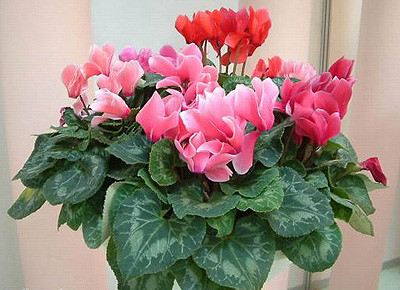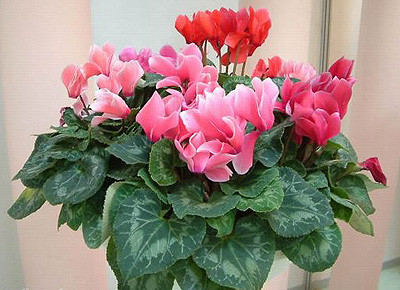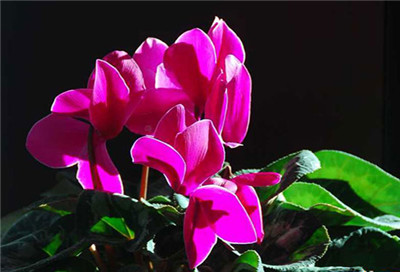How to maintain cyclamen in summer
Cyclamen likes cool and humid climate, and the most suitable temperature for growth is 15 ~ 20 degrees Celsius. When the temperature exceeds 30 degrees Celsius, it is easy to fall leaves and enter a dormant state; when it exceeds 35 degrees Celsius, it is prone to heat decay and even death. In summer, to make cyclamen live well, the most important thing is to cool down.
1. Keep the environment cool. Cyclamen is a low-temperature bulb flower, likes cold, humid and sunny environment, it is most afraid of hot summer, especially Lao Qiu. Although the new ball has strong resistance, it will stop growing and show semi-dormancy in the hot climate. Therefore, before the advent of the height of summer, the new plants should be placed in a cool, ventilated and sheltered place, receive some light, go to the shade and drink on the ground at noon to lower the temperature. For perennial old plants, it is appropriate to put them under the north balcony, windowsill or shaded eaves in summer. When the weather is hot, often drink to the ground to cool and humidify, but the basin soil should not be too wet.
2. Rational fertilization and watering. Flowering cyclamen, after the temperature rises in summer, the leaves will gradually wither and yellowing, at this time should reduce watering, so that the bulb into a dormant state. After the leaves wither and the basin soil is dry, it should be placed in a ventilated and shaded place, but the basin soil should not be too dry, otherwise it will make the seed ball dry and die. For the new plants of the same year, we should stop fertilization and control watering after June, and wait for the weather to turn cool, and then increase water and fertilizer to promote the growth of tubers and leaves. If the seedlings sown before the Spring Festival, they can blossom in the same year. For perennial plants, watering was gradually reduced and fertilization stopped from the beginning of summer to the beginning of June. After the weather turns cool in early September, pour a little more water to make the basin soil slightly moist, then the tuber gradually germinates new buds, and when the new buds grow to 3 cm high, turn the basin to change the soil. Strengthen the management of fertilizer and water to make it see more sunshine, which is conducive to the formation of flower buds, and can blossom one after another before and after the Spring Festival.
3. Turn the basin and change the soil in time. From July to August every year, cyclamen goes into dormancy and all the leaves fall off. Cyclamen turns cool in September and new buds sprout, so you should turn the basin and change the soil in time. When changing the soil, try to hurt the new roots as little as possible, and only remove the necrotic old roots. Soak the seed ball in 0.1% potassium permanganate solution for 10 minutes, then soak it in 5~1oppm gibberellin solution for 15 minutes, take it out to dry and reload it into the basin, which can relieve dormancy and promote its recovery. Planting bulbs should be shallow rather than deep, so that three-thirds of the bulbs should live on the soil.

How to maintain cyclamen in summer?
Common sense tells us that with high temperature and large evaporation in summer, flowers and plants should be watered more to avoid being dried to death. Especially flower growers like me, who have shou and jian, feel itchy when they see that the soil is dry.
But common sense often has a premise, some flowers dormant in the summer, slow metabolism, growth stagnation, and then give them a lot of water, then you may not see them sprout again.
When the summer temperature is high, some heat-sensitive plants will resist by dormancy. At this time, they will stop growing and their leaves will turn yellow and fall off, but do not misunderstand that they have been raised and killed by you.
These plants are not idle when they are asleep, transpiration continues, and the roots need a certain amount of humidity, so the water can not be completely cut off.
Summer fully dormant flowers enter the dormancy period earlier, most of the early summer, the leaves will fall off, such as cyclamen, dragon claw flower, Lycoris and so on. The dormancy period of semi-dormant flowers begins in midsummer, almost stops growing or grows slowly, accompanied by leaf withering and shedding, such as carnation, crabapple, bamboo crabapple, fragrant wormwood, geranium and so on.
Let's see how to help these dormant plants through the summer.
The immortal guest comes
Cyclamen is an annual flower, which blossoms before and after the Spring Festival. in summer, more than 30 ℃ will slowly dormant, and the leaves will wither and yellow. Cyclamen, which likes a cool and shady environment, is easy to rot when it is more than 35 ℃, so it will generally be completely dormant.
▶ dormant maintenance:
1. Keep the petiole of 5cm, trim all the leaves, dig up the root and soil, and remove some unnecessary old roots without harming the root.
two。 Transplant the repaired plants into a new pot one circle larger than the original pot, and replace the medium with more granular soil to create a loose, permeable and well-drained soil environment to avoid rotting roots.
3. The 1par 3 of the tuber is exposed to the soil and can not bury the growing point.
4. The dormant flowerpot is transferred to a cool place where there is no direct sunlight and no rain.
5. After the soil is dry, then pour a small amount of water, pay attention to avoid the sphere, water at the edge, waiting for autumn resurrection.
Bulbous plants such as daffodils, tulips, hyacinths and freesia are also dormant in summer. Their bulbs can be dug up and stored in a ventilated, cool and dry place.
Maintenance methods of cyclamen in summer
Cyclamen is a perennial herb of Primulaceae, which blossoms during the Spring Festival. Flowers are surrounded by bright and beautiful flowers at the top. Cyclamen is deeply loved by people and is a common variety of family flowers. Cyclamen likes a warm environment, can not bear high temperature and cold, the highest temperature should not exceed 30 ℃, otherwise it will enter dormancy, and it is easy to rot and necrosis under the high temperature of about 35 ℃. How to make it safe to spend the summer has become the key to raising cyclamen. Xianke summer maintenance is divided into current year new plant maintenance and perennial old plant maintenance. The maintenance of new seedlings in that year: in summer, cool environment should be created, cooling measures should be taken, and water should be sprayed and shaded frequently to make it continue to grow. after summer, the new plants should be placed in a cool and ventilated place to receive some light, and then stop fertilizing and control watering. After the weather turns cool, water and fertilizer are added to promote the stems and leaves to grow healthily. Maintenance of perennial plants: the Beginning of Summer put it under the north balcony, windowsill or shaded eaves. Starting from late May, gradually reduce watering, stop fertilizing, pay attention to ventilation, basin soil should not be too wet, micro-tide is better. Cyclamen is afraid of waterlogging, if too much watering, so that the water in the basin soil is often in a state of saturation, then tubers and roots for a long time in the state of asphyxiation, easy to lead to tuber rot. After the weather turns cool in October, you should properly pour more water to make the basin soil slightly moist, and then gradually sprout new buds. When the new buds grow to about 3 centimeters, change the pots and change the soil, strengthen the management of water and fertilizer, make them see more sunshine, which is conducive to the formation of flower buds. It can bloom before and after the Spring Festival.
- Prev

How to water cyclamen scientifically
Cyclamen is a kind of flower that is very sensitive to water. Too little watering can easily cause plant wilting, and too much watering can easily make cyclamen rot its roots. Improper watering methods can easily cause damage to cyclamen. Special attention should be paid to cyclamen cultivation. Cyclamen likes water to avoid dampness, and the basin soil needs to be kept moist.
- Next

How to aquaculture cyclamen?
Water-raised cyclamen can not only avoid the problems of easy disease and frequent watering, but also have higher ornamental value and economic benefits. The florescence of water-raised cyclamen is 1 to 2 weeks longer than that of soil-raised cyclamen, and the color is more bright, as follows: 1. Choose cyclamen.
Related
- Fuxing push coffee new agricultural production and marketing class: lack of small-scale processing plants
- Jujube rice field leisure farm deep ploughing Yilan for five years to create a space for organic food and play
- Nongyu Farm-A trial of organic papaya for brave women with advanced technology
- Four points for attention in the prevention and control of diseases and insect pests of edible fungi
- How to add nutrient solution to Edible Fungi
- Is there any good way to control edible fungus mites?
- Open Inoculation Technology of Edible Fungi
- Is there any clever way to use fertilizer for edible fungus in winter?
- What agents are used to kill the pathogens of edible fungi in the mushroom shed?
- Rapid drying of Edible Fungi

